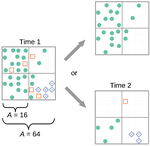Abstract
Aim Biodiversity loss is a key component of biodiversity change and can impact ecosystem services. However, estimation of the loss has focused mostly on per-species extinction rates measured over a limited number of spatial scales, with little theory linking small-scale extirpations to global extinctions. Here, we provide such a link by introducing the relationship between area and the number of extinctions (number of extinctions–area relationship; NxAR) and between area and the proportion of extinct species (proportion of extinctions–area relationship; PxAR). Unlike static patterns, such as the species–area relationship, NxAR and PxAR represent spatial scaling of a dynamic process. We show theoretical and empirical forms of these relationships and we discuss their role in perception and estimation of the current extinction crisis.
Location U.S.A., Europe, Czech Republic and Barro Colorado Island (Panama).
Time period 1500–2009.
Major taxa studied Vascular plants, birds, butterflies and trees.
Methods We derived the expected forms of NxAR and PxAR from several theoretical frameworks, including the theory of island biogeography, neutral models and species–area relationships. We constructed NxAR and PxAR from five empirical datasets collected over a range of spatial and temporal scales.
Results Although increasing PxAR is theoretically possible, empirical data generally support a decreasing PxAR; the proportion of extinct species decreases with area. In contrast, both theory and data revealed complex relationships between numbers of extinctions and area (NxAR), including nonlinear, unimodal and U-shaped relationships, depending on region, taxon and temporal scale.
Main conclusions The wealth of forms of NxAR and PxAR explains why biodiversity change appears scale dependent. Furthermore, the complex scale dependence of NxAR and PxAR means that global extinctions indicate little about local extirpations, and vice versa. Hence, effort should be made to understand and report extinction rates as a scale-dependent problem. In this effort, estimation of scaling relationships such as NxAR and PxAR should be central.
